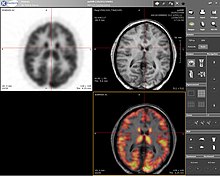PET-MRI
This article has multiple issues. Please help improve it or discuss these issues on the talk page. (Learn how and when to remove these template messages)
No issues specified. Please specify issues, or remove this template. |
It has been suggested that this article be merged into Positron emission tomography. (Discuss) Proposed since August 2013. |

PET-MRI is a hybrid imaging technology that incorporates MRI soft tissue morphological imaging and PET functional imaging. Currently three companies offer combined PET-MR systems: Philips, Siemens and GE. The first two clinical whole body PET-MRI systems were installed by Philips at Mount Sinai Medical Centre in the United States[1] and at Geneva University Hospital in Europe.[2]
Applications
Main clinical fields of PET-MRI are oncology[3][4][5], cardiology[6], neurology[7]. Research studies are actively conducted at the moment to understand benefits of the new PET-MRI diagnostic method. The technology combines the exquisite structural and functional characterisation of tissue provided by MRI with the extreme sensitivity of PET imaging of metabolism and tracking of uniquely labeled cell types or cell receptors. There is discussion and investigation into utilizing PET-MR with Ion Therapy for the purpose of cancer treatment.[citation needed] MRI's ability to accurately depict the proton density of tissue is a good match for the benefits and technical challenges of treatment planning utilizing Ion Therapy systems.
Clinical systems
Currently Siemens is the only company to offer a fully integrated whole body and simultaneous acquisition PET-MRI system. This system received a CE mark[8] and FDA approval[9] for customer purchase in 2011. Over thirty facilities have since installed this technology.
Preclinical systems
Currently, the combination of positron emission tomography (PET) and magnetic resonance imaging (MRI) as a hybrid imaging modality is receiving great attention not only in its emerging clinical applications but also in the preclinical field. Several designs based on several different types of PET detector technology have been developed in recent years, some of which have been used for first preclinical studies.[10] [11] [12]
A preclinical PET-MRI system with sequential acquisition is commercially available from Mediso Medical Imaging Systems since 2011. The first nanoScan PET-MRI system was installed at Karolinska Experimental Research and Imaging Centre of Karolinska Institutet in March 2011. The compact imaging system utilizes magnetically shielded position sensitive photomultiplier tubes and a compact 1 Tesla permanent magnet MRI platform. The integration has no adverse effects on the PET or on the MRI performance due to increased magnetic shielding of the PET component and low fringe field of the MRI component based on the performance evaluation of the system.[13]
Bruker Biospin, in collaboration with the University of Tübingen, have produced commercial prototype systems for their preclinical MRI magnets utilising a Siemens PET platform. The first such system comprising a 7T Clinscan MRI with the PET insert was installed at the CAI in Brisbane Australia in 2012.
Hybrid PET MRI systems require special devices that balance tradeoffs between PET attenuation and MRI performance. As of May 2013, Hybrid MR Inc has formed to provide 3rd party manufacturing of preclinical PET compatible MRI devices.
PET-MRI versus PET-CT
Comparisons have been made between PET-MRI and PET-CT, some sources stating that PET-MRI is simply a radiation-free version of PET-CT. In reality, there are differences beyond radiation dose, more specifically the images produced and the better contrast among soft tissues.[14]
See also
References
- ^ http://www.mssm.edu/research/labs/imaging-science-laboratories/facilities
- ^ http://www.hug-ge.ch/hug_cite/inauguration_PET_IRM.html
- ^ http://jnm.snmjournals.org/content/53/6/928.full.pdf
- ^ http://jnm.snmjournals.org/content/53/8/1244.full.pdf
- ^ http://jnm.snmjournals.org/content/53/9/1415.full
- ^ http://jnm.snmjournals.org/content/54/3/402.full.pdf
- ^ http://www.nih.gov/news/health/sep2011/cc-26.htm
- ^ "Siemens receives CE mark for whole-body molecular MR system". Healthcare Sector, Siemens AG. 2011-06-01. Retrieved 2014-01-05.
- ^ "FDA clears new system to perform simultaneous PET, MRI scans". U.S. Food and Drug Administration. 2011-06-10. Retrieved 2014-01-04.
- ^ Judenhofer, Martin S.; Cherry, Simon R. (2013). "Applications for Preclinical PET/MRI". Seminars in Nuclear Medicine. 43 (1): 19–29. doi:10.1053/j.semnuclmed.2012.08.004. PMID 23178086.
- ^ Schulz, Volkmar; Weissler, Bjoern; Gebhardt, Pierre; Solf, Torsten; Lerche, Christoph; Fischer, Peter; Ritzert, Michael; Piemonte, Claudio; Goldschmidt, Benjamin; Vandenberghe, Stefaan; Salomon, Andre; Schaeffter, Tobias; Marsden, Paul (2011). "SiPM based preclinical PET/MR insert for a human 3T MR: first imaging experiments". Nuclear Science Symposium and Medical Imaging Conference (NSS/MIC), 2011 IEEE: 4467–4469. doi:10.1109/NSSMIC.2011.6152496.
- ^ Wehner, Jakob; Weissler, Bjoern; Dueppenbecker, Peter; Gebhardt, Pierre; Schug, David; Ruetten, Walter; Kiessling, Fabian; Schulz, Volkmar (2013). "PET/MRI insert using digital SiPMs: Investigation of MR-compatibility". Nuclear Instruments and Methods in Physics Research Section A: Accelerators, Spectrometers, Detectors and Associated Equipment. doi:10.1016/j.nima.2013.08.077.
- ^ Nagy, Kálmán; Tóth, Miklós; Major, Péter; Patay, Győző; Egri, G.; Häggkvist, Jenny; Varrone, Andrea; Farde, Lars; Halldin, Christer; Gulyás, Balázs (2013). "Performance Evaluation of the Small-Animal nanoScan PET/MRI System". Journal of Nuclear Medicine. doi:10.2967/jnumed.112.119065.
- ^ Pichler, Bernd J.; Judenhofer, Martin S.; Pfannenberg, Christina (2008). "Multimodal Imaging Approaches: PET/CT and PET/MRI". In Semmler, Wolfhard; Schwaiger, Markus (eds.). Molecular Imaging I. Handbook of Experimental Pharmacology. Vol. 185/1. pp. 109–32. doi:10.1007/978-3-540-72718-7_6. ISBN 978-3-540-72717-0.
